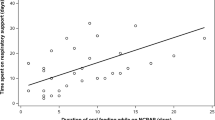Abstract
Safety and efficacy of oral feeding was examined in infants with bronchopulmonary dysplasia (BPD) on nasal continuous positive airway pressure (NCPAP). We hypothesized that repetitive oral feeding enhances aero-digestive outcomes and reduces resource utilization. Data from infants with BPD (37–42 weeks post menstrual age) that were orally fed while on NCPAP (n = 26) were compared with those that were exclusively gavage fed on NCPAP (n = 27). Subject assignment was random and physician practice based. Specifically, we compared the differences in aero-digestive milestones, resource utilization, and safety metrics. Demographic characteristics such as gender distribution, gestational age, and birth weight, clinical characteristics such as frequency of intraventricular hemorrhage and patent ductus arteriosus needing surgical ligation were similar in both groups (p > 0.05). Characteristics of respiratory support and airway milestones were similar in both groups (p > 0.05). However, infants in NCPAP-oral fed group had earlier acquisition of full oral feeding milestone by 17 days (median) versus infants who were not orally fed during NCPAP (p < 0.05). Discharge weights and the frequency of gastrostomy tube placement were also similar in both groups (p > 0.05). There were no tracheostomies in either group. There was no incidence of clinically significant aspiration pneumonia in infants during the period of the oral feeding while on NCPAP. Controlled introduction of oral feedings in infants with BPD during NCPAP is safe and may accelerate the acquisition of oral feeding milestones.


Similar content being viewed by others
References
Ehrenkranz RA, Walsh MC, Vohr BR, Jobe AH, Wright LL, Fanaroff AA, Wrage LA, Poole K. Validation of the National Institutes of Health consensus definition of bronchopulmonary dysplasia. Pediatrics. 2005;116:1353–60.
Davidson E, Hinton D, Ryan-Wenger N, Jadcherla S. Quality improvement study of effectiveness of cue-based feeding in infants with bronchopulmonary dysplasia in the neonatal intensive care unit. Jognn-J Obst Gyn Neo. 2013;42:629–40.
Jadcherla SR, Wang M, Vijayapal AS, Leuthner SR. Impact of prematurity and co-morbidities on feeding milestones in neonates: a retrospective study. J Perinatol. 2010;30:201–8.
Fucile S, McFarland DH, Gisel EG, Lau C. Oral and nonoral sensorimotor interventions facilitate suck-swallow-respiration functions and their coordination in preterm infants. Early Hum Dev. 2012;88:345–50.
Mason SJ, Harris G, Blissett J. Tube feeding in infancy: implications for the development of normal eating and drinking skills. Dysphagia. 2005;20:46–61.
Rochat P, Goubet N, Shah BL. Enhanced sucking engagement by preterm infants during intermittent gavage feedings. J Dev Behav Pediatr. 1997;18:22–6.
Jaile JC, Levin T, Wung JT, Abramson SJ, Ruzal-Shapiro C, Berdon WE. Benign gaseous distension of the bowel in premature infants treated with nasal continuous airway pressure: a study of contributing factors. AJR Am J Roentgenol. 1992;158:125–7.
Jadcherla SR, Hoffmann RG, Shaker R. Effect of maturation of the magnitude of mechanosensitive and chemosensitive reflexes in the premature human esophagus. J Pediatr. 2006;149:77–82.
Penn AA, Shatz CJ. Brain waves and brain wiring: the role of endogenous and sensory-driven neural activity in development. Pediatr Res. 1999;45:447–58.
Als H, Lawhon G, Duffy FH, McAnulty GB, Gibes-Grossman R, Blickman JG. Individualized developmental care for the very low-birth-weight preterm infant. Medical and neurofunctional effects. JAMA. 1994;272:853–8.
Als H, Tronick E, Lester BM, Brazelton TB. The Brazelton Neonatal Behavioral Assessment Scale (BNBAS). J Abnorm Child Psychol. 1977;5:215–31.
Wolf LS, Glass RP. Feeding and swallowing disorders in infancy: assessment and management. Tucson: Therapy Skill Builders; 1992.
Ross ES, Philbin MK. Supporting oral feeding in fragile infants: an evidence-based method for quality bottle-feedings of preterm, ill, and fragile infants. J Perinat Neonatal Nurs. 2011;25:349–57 quiz 358-349.
Hansen TN, Cooper TR, LE Weisman. Copyright paperback collection (library of congress): contemporary diagnosis and management of neonatal respiratory diseases. 1st ed. Newtown: Handbooks in Health Care; 1995.
Gewolb IH, Bosma JF, Reynolds EW, Vice FL. Integration of suck and swallow rhythms during feeding in preterm infants with and without bronchopulmonary dysplasia. Dev Med Child Neurol. 2003;45:344–8.
Gewolb IH, Bosma JF, Taciak VL, Vice FL. Abnormal developmental patterns of suck and swallow rhythms during feeding in preterm infants with bronchopulmonary dysplasia. Dev Med Child Neurol. 2001;43:454–9.
Lefton-Greif MA, McGrath-Morrow SA. Deglutition and respiration: development, coordination, and practical implications. Semin Speech Lang. 2007;28:166–79.
Jadcherla SR, Peng J, Moore R, Saavedra J, Shepherd E, Fernandez S, Erdman SH, DiLorenzo C. Impact of personalized feeding program in 100 NICU Infants: pathophysiology-based approach for better outcomes. J Pediatr Gastroenterol Nutr. 2012;54:62–70.
Bernier A, Catelin C, Ahmed MA, Samson N, Bonneau P, Praud JP. Effects of nasal continuous positive-airway pressure on nutritive swallowing in lambs. J Appl Physiol. 1985;112:1984–91.
Simpson C, Schanler RJ, Lau C. Early introduction of oral feeding in preterm infants. Pediatrics. 2002;110:517–22.
Jobe AH, Bancalari E. Bronchopulmonary dysplasia. Am J Respir Crit Care Med. 2001;163:1723–9.
Barlow SM. Oral and respiratory control for preterm feeding. Curr Opin Otolaryngol Head Neck Surg. 2009;17:179–86.
Acknowledgments
We acknowledge the Comprehensive Center for Broncho-Pulmonary Dysplasia at Nationwide Children’s Hospital for invaluable cooperation. Jadcherla’s efforts are supported in part by Grants NIH R01(DK) 068158 and NIH P01(DK) 068051.
Conflict of interest
The authors declare that they have no conflict of interest.
Author information
Authors and Affiliations
Corresponding author
Additional information
Melissa Hanin and Sushma Nuthakki contributed equally to manuscript and were co-first authors.
Rights and permissions
About this article
Cite this article
Hanin, M., Nuthakki, S., Malkar, M.B. et al. Safety and Efficacy of Oral Feeding in Infants with BPD on Nasal CPAP. Dysphagia 30, 121–127 (2015). https://doi.org/10.1007/s00455-014-9586-x
Received:
Accepted:
Published:
Issue Date:
DOI: https://doi.org/10.1007/s00455-014-9586-x




